California Dreamin’ Pt. 4
Greetings!
In the annals of the legendary British King Arthur, Avalon was the magical island where the sword Excalibur was forged, and where, after the battle of Camlann, Arthur was taken by the enchantress Morgan le Fay to recover from his wounds. In some versions of the legend, Arthur died there, but in others, he recovered and is waiting for the right moment in history to be reincarnated.
Today, the word Avalon is perhaps more familiar to many Americans as the name of Toyota’s largest front wheel drive passenger car, or else as the only city on Santa Catalina Island (often simply abbreviated to Catalina), just off the coast of California. It is in the latter connection that Avalon becomes central to this week’s essay. I have included pictures of various birds and animals on Catalina in more than one recent essay, but in this one it is the island itself that is the focus of the story.
Ruthi and I embarked on the mid-morning high-speed ferry from San Pedro to Avalon. Although the modern Avalon is real enough, there was certainly magic in the air, since we proceeded most of the way – 26 miles according to the song – through a dense sea mist during which we saw the natural phenomenon known as fog bow, or white rainbow.
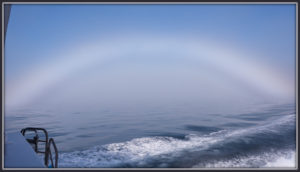
The optics of a fog bow are very similar to a regular rainbow, but the water droplets in the fog are much smaller than typical rain drops, so no strong color bands are formed. The mist was still quite thick when we arrived at Avalon, so I had to wait to take the iconic picture* of the Casino
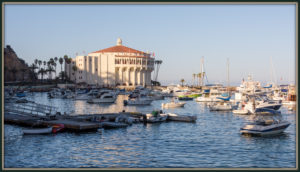
which is not, and never has been, a gambling establishment. It was built in 1929 by William Wrigley Jr. as part of his effort to promote Catalina Island as a playground for the rapidly growing Hollywood crowd. In Italian “casino” means “gathering place”, and this is what it was meant to be. It includes what is said to be the first theater in the world acoustically designed for “talking pictures”, as well as a vast ballroom. Later designated as Catalina Island’s civil defense shelter, it can accommodate the entire year round population of the island, and contains within its walls enough food and drink to last them for two weeks.
Originally known as Timm’s Landing, by 1883 the tiny settlement boasted about thirty tents and about three wooden buildings. Ownership had changed hands more than once when, in about 1887, the sister-in-law of the then-current owner George Shatto, decided the name Avalon had a romantic ring to it – she was a King Arthur fan – and would help encourage tourism, although Avalon had not grown much by 1891 when Shatto sold it to the Banning Brothers. Their efforts to develop Avalon were halted by a disastrous fire in 1915 that destroyed most of the town. At that point, Mr. Wrigley Jr. effectively purchased the island from the Banning Brothers, and his development and promotional efforts were highly successful, with Avalon and Catalina hosting not just a galaxy of film stars, but also being used as a filming location for many movies (the present wild bison are the descendants of some brought in as movie “extras”). For a number of years before World War 2 Wrigley even brought his Chicago Cubs there for spring training.
Like many visitors, Ruthi and I arrived by ferry, not unlike the one on the right hand side of this picture.
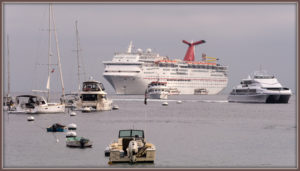
Other visitors arrive by cruise ships such as the Carnival Imagination also in this picture, or even by their own private boats, many of which crowd the picturesque harbor.
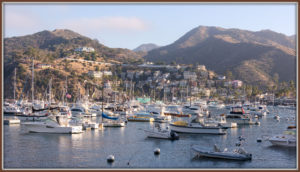
Not so very long ago, one could take frequent scheduled seaplane flights (mainly Grumman Gooses) between Avalon and the mainland (as Ruthi has done), but now air service is limited to helicopter charter flights unless you are lucky enough to own your own airplane, in which case you can fly to Catalina’s “Airport in the Sky”. You then take an exciting ride down the unpaved road to Avalon, which takes longer than the flight itself!
Avalon is a very small city, ideally sized for simply wandering around on foot, soaking up the atmosphere. It does have a museum, and our trip to Catalina happened to fall during the time that the museum featured a display of art glass by Dale Chihuly. The pieces on show – which we understand are from his personal collection – ranged from gorgeous semi-abstract “sea forms” such as the one on the left below, to large works shown outdoors such as the one on the roof of the museum shown on the right below. The blue piece in the middle is not Chihuly. It is a piece from classical Roman times which we saw at the Getty Villa just outside Los Angeles (see my November 20 post), but I think makes a fascinating comparison with the Chihuly pieces.
We thoroughly enjoyed the Chihuly exhibit. The docent on duty was extremely welcoming and fascinating to chat with, as we were able to do since the gallery was almost deserted. It was only after our visit that we realized that “our” docent was none other than Chuck Liddell, the iconic local historian, guide, and writer, often known as “Catalina’s Google”.
The Chihuly exhibit was not the only colorful art we saw – at least if you can call beer cans nailed to a tree “art”!
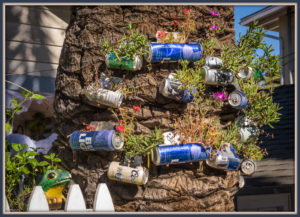
The 2010 census shows the total population of Santa Catalina Island to be 4,096, of whom the vast majority (3,728) live within the City of Avalon. Apart from a few campgrounds and research stations, the only other town on the island is Two Harbors, with a population of about 300, of whom only half are year-round residents. Although it is less than 12 miles from Avalon as the crow flies, visitors have to take three separate buses to get there by road. The first stage involves a switch-back climb (with wonderful views) to the airport.
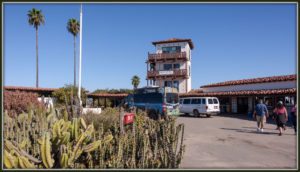
The day we went, after a half-hour break for lunch at the quaint airport restaurant/gift shop, the same bus (the colorful one in the center of the picture*) and driver took us on the second leg of the journey. This leg also followed a winding gravel road, part of which can be seen on the left of this picture*
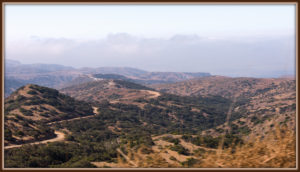
which took us down to the camp-ground/bus station at Little Harbor.
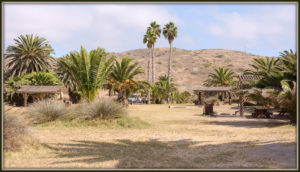
After waiting here for several minutes, the driver announced that the bus that should have come out from Two Harbors to meet us was not coming, so we and a few backpackers got back into the same bus for the third sector, along similar gravel roads. (It seems that outside Avalon and Two Harbors, there are no paved roads on the island.) When we finally got to Two Harbors, our super-nice driver decided that, since he was already running very late, a few more minutes wouldn’t matter, and he drove us the half-mile or so up a steep (gravel) road to our hotel, rather than have us wait for the hotel shuttle! His kindness and good-nature was typical of all the “natives” we met.
Ruthi and I had wanted to go to Two Harbors partly because of its interesting geographical situation. At this location the island is almost divided into two by a low-lying isthmus. On the west end of the isthmus is the harbor on the Pacific Ocean side of the island, while less than half a mile to the east is the harbor on the San Pedro Channel (mainland) side. The latter is the busier of the two, and one can catch the ferry to the mainland or (as we did at the end of our stay) back to Avalon. Our hotel – the Banning House Lodge – affords views all across the isthmus.
The Lodge was originally built by the Banning Brothers in 1910 as a hunting lodge. A very peaceful getaway spot, there are no phones or TVs in the (total of twelve) rooms, and no WiFi! Better still, every night there is a free wine and cheese tasting hour for the guests! Sadly, our overall itinerary only allowed one night at the Lodge, and the following day we caught the ferry back to Avalon and took a last look at the boats in the harbor* before departing for the mainland.
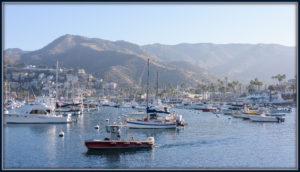
Hopefully, this post will have stirred some fond memories for you if you have been to Catalina, or will make you think about going there if you ever have the opportunity in the future.
Have a great week!
P.S. In the interest of full disclosure, and since I know some of you try to look into the metadata of my photos, I point out that some of the photos used above (indicated by the “*”) were taken on either the day before or after the narrative might suggest, but they accurately portray what we saw.
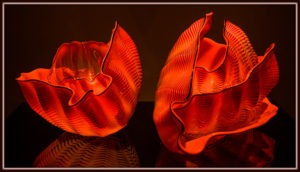

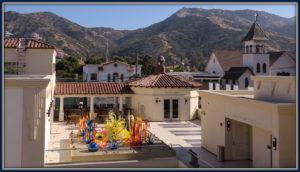
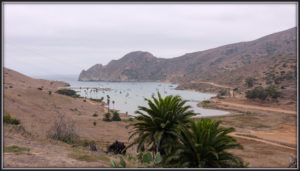
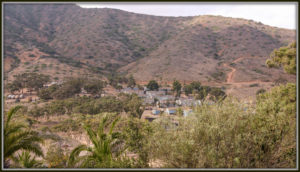
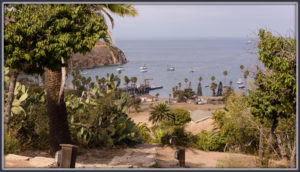
One thought on “California Dreamin’ Pt. 4”
Absolutely fantastic essay. Makes you want to go there to experience it yourself.
Comments are closed.